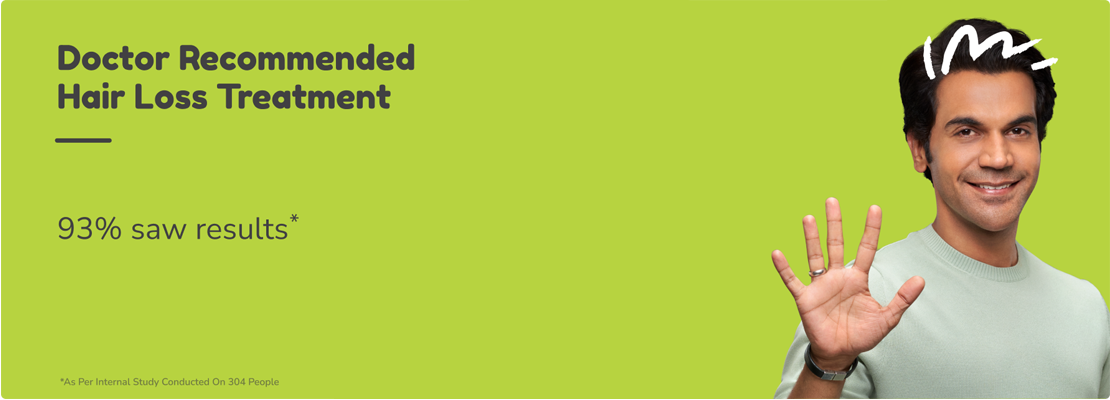Hair loss might be a very common phenomenon and some kinds of hair loss might be irreversible but we believe that you should never give up on your hair. There might be hope yet in those worst situations and that is why you should never stop believing and keep working to set your hair right. Hair loss could result from any number of problems including hormonal changes, hereditary & medical issues, and old age too. While hair loss is more common in men it could happen to women too.
While it is normal to lose anything up to 100 strands a day, any sudden and abnormal hair loss needs to be treated soon so that the situation does not worsen. Any sudden escalation in hair loss is a result of telogen effluvium which could be triggered by medical, emotional, or other physical factors. Androgenic alopecia is another reason for the loss of hair. This sort of hair loss is caused by genetic and hormonal factors.
Hair Loss Typically Happens Because Of Any One Of The Following Reasons:
- Heredity: This is usually because of a hereditary condition that happens because of aging, also called male-pattern baldness and female-pattern baldness. This is characterized by bald spots and a receding hairline in men and gradual hair loss along the crown of women. Both are referred to as androgenetic alopecia or pattern hair loss.
- Hormonal problems: Hormonal problems due to childbirth, menopause, or pregnancy could cause hair fall and hair thinning.
- Medications: Hair loss could also be a result of the medication taken for various ailments such as high blood pressure, arthritis, gout, or depression.
- Radiation therapy to the head: Radiation therapy can lead to hair fall and while the hair could grow back, it might not have the same quality and thickness or even appear the same.
- Stress-related hair fall: Very extreme cases of mental or physical stress might lead to hair falls. This is one of the common causes of hair loss.
- Hairstyles and hair treatments: Hairstyles that tend to stretch your strands or harsh hair treatment procedures that affect your scalp force hair to fall out. When hair is pulled very tightly backward regularly it could lead to permanent hair loss and is referred to as traction alopecia.
The hair growth cycle is divided into 3 phases the anagen, catagen, and telogen phases which are essentially the growth, transition, and shedding phases respectively. At least 3% of your hair is in the catagen phase at any point in time. Anagen is the phase of growth and the follicles during this phase can last for 2-6 years. Catagen is the phase of no growth as the outer sheath contracts and attaches itself to the root of the hair and this phase lasts for 2-3 weeks. Telogen is the rest period that lasts for 3 months and finally ends with the development of anagen hair. Under normal circumstances, 10-15% of the hair is in the telogen phase but it could easily be altered or increased by several physical or mental factors such as illness, infections, sickness, surgery, and pregnancy among other things.
Hair loss can also happen because of a condition called alopecia areata, an autoimmune condition that causes patchy hair loss. This sort of hair loss is sudden and is typified by circular bald patches on the scalp; the patches could overlap. Here, the immune system tends to attack the hair follicles which could be brought on by severe stress. The stress causes the excess production of cortisol which moves the follicles from the growing to a resting phase. Stress-related hair loss is temporary because as soon as you find ways to relax your body and effective ways to deal with your stress, you will be able to stop your hair from falling over time.
Before adopting any procedure of treatment, it is advisable to focus on the root cause and find solutions for it. If the cause is any fever or illness from which you have since recovered, you needn’t worry. Focus on a good nutritious diet and your stress will be on the road to recovery in no time. However, if an underlying condition or body deficiency like zinc or iron is responsible, then a visit to your doctor/dermatologist will be required for detailed treatment procedures.
The doctor has to conduct a detailed diagnosis of hair loss to prescribe suggested cures. This could involve samples of skin and hair to examine under a microscope or conduct tests on. More serious problems could need blood tests or a biopsy of the scalp.
Doctors might also suggest home treatments with the use of Minoxidil which needs to be applied to the scalp once or twice a day. This will not only prevent further hair loss but will also stimulate hair growth. However, this is a treatment procedure that will need at least 3-6 months to show results.
Laser caps and combs have also yielded good results for quite a few. Microneedling whereby several tiny needles are used is known to stimulate hair growth in those with mild to moderate hair loss. However, this device needs to be used with proper medical supervision for it can aggravate the condition of some patients.
There are also several advanced hair treatment options possible including platelet-rich plasma therapy and hair mesotherapy. These procedures are essential for those with severe hair fall issues.
Ways In Which Hair Loss Takes Place
Hair loss can manifest in many different ways and this depends on the cause behind it. It could affect you very quickly or could also happen over some time. Let us look at the different ways in which hair loss can happen and some symptoms of hair loss:
-
Thinning on top of the head:
This is the most common type of hair loss and happens as the individual gets older. While men experience a receding hairline women find their hair parting broadening. Older women also experience frontal fibrosing alopecia i.e., a receding hairline.
-
Patchy or circular spots on the forehead:
Some lose patches of hair on their scalp, eyebrows, or beard. This is usually preceded by itchy and painful skin.
-
Hair could loosen suddenly:
Emotional or physical trauma can also lead to hair loss where clumps of hair come off during brushing or washing or even with a tug. This kind of hair loss is however temporary.
-
Hair loss all over the body:
This could be a result of certain treatment procedures like chemotherapy and leads to hair loss all over the body. The hair grows back in the majority of cases.
-
Scaling patches on the scalp:
This is most probably the result of ringworm and one could also experience oozing, redness, and swelling.
Precautions
There are some standard precautions that you could take to prevent hair loss.
- Go gentle on your hair: Do not tug or pull your hair too hard while combing, especially when it is wet. Avoid harsh methods of hair treatment with heat rollers, irons, and hot oils.
- Be careful with your medication: Take the right suggestions from your doctor to use medication that does not interfere with the health of your hair.
- Use protection from the sun: Always wear headgear when you venture out to protect yourself from UV rays. You can use hair serum too.
- Use a cooling cap: Use a cooling cap if you are undergoing chemotherapy. This will help reduce hair loss.
- Hair massage: A gentle hair massage once a week also helps improve blood circulation and stimulates the hair roots for better hair growth.
- Relaxing activities: Meditation, yoga, art, and music are some of the options that you could explore to enhance the quality of your hair.
Takeaway:
Hair loss is inevitable for most but preventable for quite a few. For those faced with the problem of hereditary baldness, you could yet extend the longevity of your strands with proper care. The key is early diagnosis and treatment before the situation becomes irretrievable. If you have been experiencing regular hair loss for a long period, a visit to the dermatologist is due. For more details do get in touch with our experts at Traya and learn about some very effective techniques on how to make hair strong and increase the life of your tresses.




